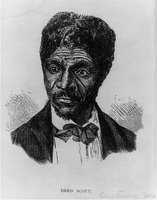Digital ID: cph 3a08411 Source: b&w film copy neg. Reproduction Number: LC-USZ62-5092 (b&w film copy neg.) Repository: Library of Congress Prints and Photographs Division Washington, D.C. 20540 USA Retrieve uncompressed archival TIFF version (1,809 kilobytes)
Dred Scott's case holds a unique place in American constitutional history as an example of the Supreme Court trying to impose a judicial solution on a political problem. It called down enormous criticism on the Court and on Chief Justice Roger Brooke Taney; a later chief justice, Charles Evans Hughes, described it as a great "self-inflicted wound."
Scott, born a slave, had been taken by his master, an army surgeon, into the free portion of the Louisiana territory. Upon his master's death, Scott sued for his freedom, on the grounds that since slavery was outlawed in the free territory, he had become a free man there, and "once free always free." The argument was rejected by a Missouri court, but Scott and his white supporters managed to get the case into federal court, where the issue was simply whether a slave had standing -- that is, the legal right -- to sue in a federal court. So the first question the Supreme Court had to decide was whether it had jurisdiction. If Scott had standing, then the Court had jurisdiction, and the justices could go on to decide the merits of his claim. But if, as a slave, Scott did not have standing, then the Court could dismiss the suit for lack of jurisdiction.
The Court ruled that Scott, as a slave, could not exercise the prerogative of a free citizen to sue in federal court. That should have been the end of the case, but Chief Justice Taney and the other southern sympathizers on the Court hoped that a definitive ruling would settle the issue of slavery in the territories once and for all. So they went on to rule that the Missouri Compromise of 1820 was unconstitutional since Congress could not forbid citizens from taking their property, i.e., slaves, into any territory owned by the United States. A slave, Taney ruled, was property, nothing more, and could never be a citizen. INTRODUCTION TO THE COURT OPINION ON THE DREDD SCOTT CASE
Credit Line: Library of Congress, Prints and Photographs Division [reproduction number, LC-USZ62-5092]
MARC Record Line 540 - No known restrictions on publication.
Works published prior to 1978 were copyright protected for a maximum of 75 years. See Circular 1 "COPYRIGHT BASICS" from the U.S. Copyright Office. Works published works before 1923 are now in the public domain
Leave a comment, make a request, Let this small sampling be a guide to better quality, more plentiful, public domain, royalty free, copyright free, high resolution, images, stock photos, jpeg, jpg, free for commercial use, clip art, clipart, clip-art. more at Public Domain Clip Art and clip art or public domain and Black History Month














No comments:
Post a Comment